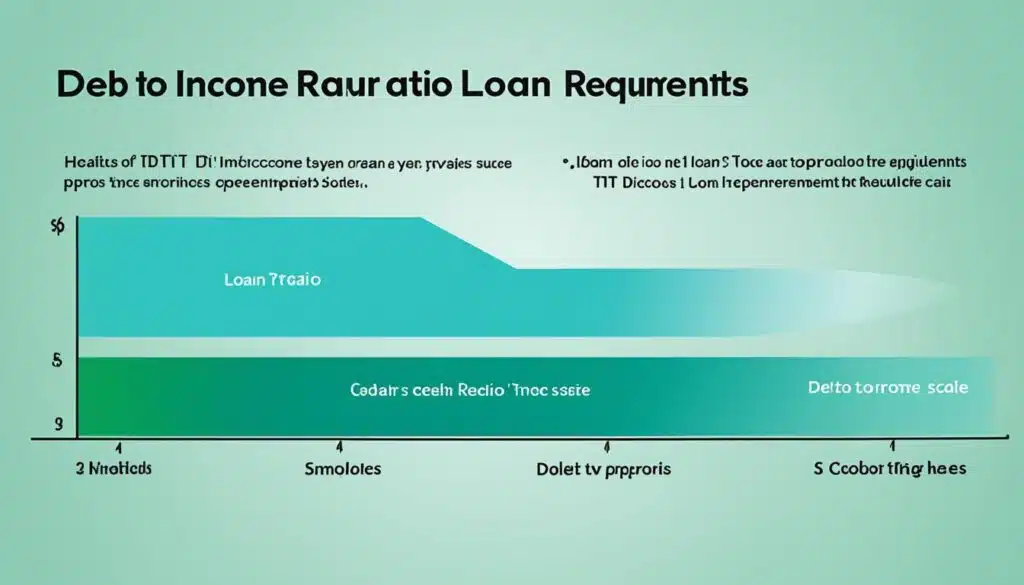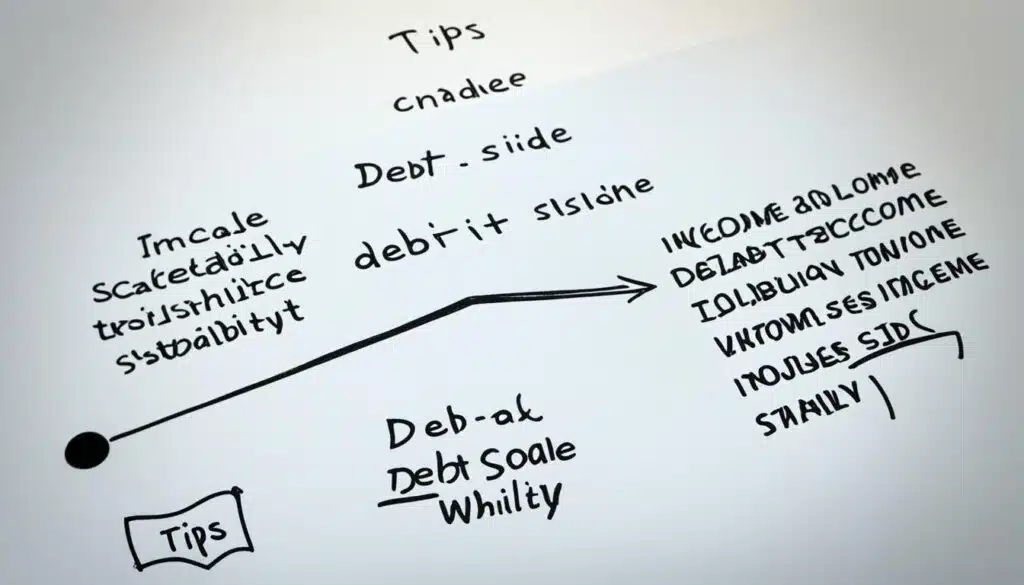When you apply for a loan, like a mortgage or auto loan, your debt-to-income (DTI) ratio is very important. It shows how much you owe compared to how much you earn each month. If your ratio is high, it might be hard to get the loan. This is because lenders may think you already have too much debt and might not pay them back.
Lenders usually want your debt-to-income ratio to be 36% or lower. However, some might still give you a loan if it’s up to 45-50%. Your total debts each month should not be more than 36% of what you earn. They use this number to check if you can easily pay back a new loan. This helps keep you from buying more than you can handle.
Your debt-to-income ratio is key when applying for a mortgage. A low ratio means you stand a better chance at the loan and a good interest rate. This could get you better terms and lower payments.
Key Takeaways
- A high debt-to-income ratio can make it difficult to get approved for a loan, as it signals to lenders that you may be overextended and at risk of defaulting on your payments.
- Lenders typically prefer a debt-to-income ratio of 36% or less, though some may accept ratios up to 45-50% in certain cases.
- The debt-to-income ratio is a crucial factor in the mortgage approval process, as it provides lenders with a comprehensive understanding of your financial strength and stability.
- Maintaining a low debt-to-income ratio can improve your chances of getting approved for a loan and potentially secure a better interest rate.
- Factors like credit score, credit history, and income stability also play a significant role in the loan approval process.
Understanding Debt-to-Income Ratio
Understanding the debt-to-income (DTI) ratio is key in managing your finances well. It’s the percentage of your gross monthly income that you use for various payments. These payments include mortgages, auto loans, and credit cards.
What is a Debt-to-Income Ratio?
The debt-to-income ratio shows how much of your income goes to debts each month. You find this by dividing your monthly debt payments by your gross monthly income. Lenders use this number to see your financial health and wise use of credit.
Importance of DTI for Lenders
Lenders deeply consider your debt-to-income ratio for loans, especially mortgages. It tells them if you can handle more monthly payments. They check your pre-tax income against what you owe.
Types of Debt-to-Income Ratios

When deciding if someone is creditworthy, lenders look at two main types of DTI ratios. These are the front-end ratio and the back-end ratio.
Front-End Ratio
The front-end ratio, or housing ratio, measures what part of a person’s income houses expenses. These include mortgage payments, taxes, insurance, and HOA fees. A 28% or lower front-end ratio is usually preferred by lenders.
Back-End Ratio
The back-end ratio considers the part of income that covers all debts. This includes mortgages and other loans. Lenders consider 36% or lower for the back-end ratio, but some flexibility is there for strong applicants.
Knowing about these debt-to-income ratios will help you with your mortgage process. It can increase your chances of getting through smoothly.
Calculating Your Debt-to-Income Ratio

To find your debt-to-income (DTI) ratio, you must take a few steps. Lenders rely on this number. They compare your monthly debts with your income before making loan decisions.
Step 1: Add Up Monthly Debt Payments
Add all your monthly debt, such as rent or mortgage, car loans, student loans, and credit card payments. Include all debts you pay every month. This total is what you need to cover every month.
Step 2: Divide by Gross Monthly Income
Now, divide your total monthly debts by your income before taxes. This is your gross monthly income. You’ll get a decimal number. This is your debt-to-income ratio in decimal form.
Step 3: Convert to Percentage
Then, turn the decimal into a percentage by multiplying it by 100. Lenders use this percentage to see if you can manage a new loan along with your other debts.
By doing these steps, you can calculate your debt-to-income ratio. This shows how your debts compare to your income. It’s vital for a smooth loan application process.
What is a Good Debt-to-Income Ratio?

For traditional home loans, an ideal back-end debt-to-income ratio is around 36% or lower. Some lenders might go for ratios of 45-50% if you got other good points. The front-end ratio, which is just for housing payments, should ideally be 28% or less. Lower debt-to-income ratios make it easier to get a loan and might offer better interest rates.
Most lenders look for a debt-to-income ratio of 43% or less. This number shows you manage your debts well. Keeping this ratio healthy is key to getting good loan deals and upping your mortgage approval odds.
| Ratio Type | Ideal Range | Description |
|---|---|---|
| Front-End Ratio | 28% or less | Percentage fit for housing costs, like mortgage, taxes, and home insurance. |
| Back-End Ratio | 36% or less (up to 45-50% with compensating factors) | Portion of your income for monthly debt, even beyond your mortgage. |
Keeping these ideal debt-to-income ratio tips in mind can help you document better numbers. This makes it easier to get a mortgage or other loans with good terms.
DTI Ratio Requirements by Loan Type

Getting a loan means you must know about the debt-to-income (DTI) ratios. These DTI ratios show how well you can handle your monthly debts. This is true for conventional loans, FHA loans, VA loans, and USDA loans. We’ll go over the front-end and back-end ratios you might need for each loan type.
Conventional Loans
For conventional loans, the ideal front-end ratio is 28% for housing costs. The back-end ratio should be 36% or lower. Yet, there is room if your situation is special. Some might accept up to 50% back-end ratio with strong reasons.
FHA Loans
With FHA loans, you might get a bit more flexibility. They consider 31% for front-end and 43% for back-end as standard. In special cases, like with good reasons, the back-end can stretch to 57%.
VA Loans
VA loans have no strict DTI limits but suggest a 41% back-end as a guide. Your chances may be better with good credit and a steady job. This allows lenders some leeway.
USDA Loans
The USDA loan program suggests 29% for the front-end and 41% for the back-end. But, they might allow up to a 44% back-end if your case is strong.
Remember, each lender may set their own DTI rules. It’s smart to compare offers from a few lenders. This helps you see the full loan application picture clearly.
Debt-to-Income Ratio and Credit Scores
Your debt-to-income ratio is key when you apply for a loan. But, it doesn’t directly affect your credit score. Why? Because credit reports don’t list how much you earn, keeping your ratio out of the score’s math.
Yet, the credit utilization ratio does matter a lot. It looks at how much of your credit you use. Lowering this debt can boost both your debt-to-income ratio and your credit score. And that’s good news for your home loan chances.
Show that you manage credit well, and you’re more likely to get a loan. With a great credit history and low credit use, you signal you’re reliable. That, plus a healthy debt-to-income ratio, makes lenders more likely to say yes to you.
Improving Your Debt-to-Income Ratio

It’s key to keep a good debt-to-income (DTI) ratio for loan approvals, like mortgages. Luckily, you can use a few methods to improve your DTI ratio. These help you have a better shot at getting the financing you want.
Pay Off Debt
Focus on paying off debt to lower your debt-to-income ratio. Start with loans and credit cards that have big monthly payments. This will cut your monthly money owed and improve your DTI ratio.
Refinance Existing Loans
To improve your debt-to-income ratio, consider refinancing existing loans. With a lower interest rate or a longer loan term, your monthly payments may drop. This can better your DTI.
Seek Loan Forgiveness Programs
Explore loan forgiveness programs for student loans or other debts. Getting debt forgiven can lower your debt-to-income ratio a lot.
Pay Off High-Interest Debt First
Start with high-interest debt when you’re paying off. It does the most to help your DTI ratio. Focusing on these debts first can really lower your ratio.
Get a Co-Signer
If reducing your DTI alone is tough, getting a co-signer might help. A co-signer with good credit and income can boost your mortgage application. This could up your chance of approval.
Increase Your Income
Also, increasing your income can better your DTI ratio. A better job, a side gig, or any way to earn more money can help. It allows you to handle your debts better each month, improving your DTI.
Follow these steps and keep an eye on your DTI ratio. This can lead to success in getting a loan and reaching your financial dreams.
Self-Employment and DTI Ratio
For self-employment and DTI ratio, lenders need two solid years of self-employment income documentation. You must show your income using 1099 forms during this time. This proves your income stability to the lenders. They want to make sure you can pay your mortgage each month.
Self-employment income can heavily affect your DTI ratio. The third source talks about this impact. If your self-employment income fluctuates a lot year to year, you might not qualify for a mortgage. Lenders look for a stable income on which they can rely.
To boost your loan approval as a self-employed person, keep your DTI ratio in check. Manage your 1099 income and any debt obligations well. This ensures you look financially responsible to the lenders. Show them you can handle the costs of owning a home.
Student Loan Debt and DTI Ratio
Student loan debt plays a big part in a person’s debt-to-income ratio, especially for FHA loan applicants. When applying for an FHA loan, lenders must consider the borrower’s monthly student loan payments or 1% of the outstanding student loan balance. They do this even if the student loans are still in deferment. This rule can make it harder for people with a lot of student loan debt to get a mortgage. Their debt-to-income ratio might be too high for the lenders’ limits.
Those with a lot of student loan debt might struggle to meet FHA loan requirements. FHA loans are popular among first-time and low-to-moderate-income buyers. This is because the student loan debt increases their DTI ratio, putting mortgage approval at risk.
To tackle this issue, people with high student loan balances can consider ways to lower their debt-to-income ratio. They can try refinancing their student loans for a lower monthly payment. Or, they can look into loan forgiveness programs. Doing so can help them qualify for a mortgage and reach their home buying dreams. Managing student loan debt wisely is key.
Credit Card Debt and DTI Ratio

The third source highlights how crucial it is to handle credit card debt when looking at your debt-to-income (DTI) ratio. In your DTI calculation, the minimum monthly payments of your credit cards count. So, it’s important to keep your credit card balances as low as possible. This helps decrease your monthly payments and keeps your credit worthiness in good shape. A high credit card debt can affect your mortgage approval negatively.
The source suggests being careful with credit card usage. It advises paying off what you owe to better your DTI ratio. This effort can make you more likely to get a home loan. When you use little of your available credit and cut down credit card debt, lenders see you as a responsible borrower.
Debt-to-Income Ratio

A borrower’s debt-to-income (DTI) ratio tells lenders a lot about someone’s finances. It compares their monthly debt payments to their income. This helps lenders see if a person can handle more debt.
Importance for Loan Approval
Lenders aim for a DTI ratio of 36% or lower. They want to see you can manage your monthly payments. A healthy DTI ratio boosts your chances of loan approval, especially for mortgages.
Calculating Your DTI
To find your DTI ratio, list all your monthly debt like loans and credit cards. Then, divide this by your total monthly income before taxes. After division, turn this into a percentage by multiplying by 100.
Ideal DTI Ratio Ranges
For a mortgage, most lenders want to see a DTI below 36%. Yet, they might allow up to 50% if other factors are good. Keeping your housing expenses under 28% also helps improve your mortgage chances.
Also Read : Land Loan Guide: Financing Your Dream Property
Conclusion
In closing, a person’s debt-to-income ratio is very important for getting a loan, especially a mortgage. This ratio looks at how much a person spends each month compared to their income. It shows if someone can easily take on more monthly expenses. Keeping this ratio low, ideally under 36%, helps in loan approval and getting a good interest rate.
Things like self-employment income or how much you owe in student loans or credit card debt affect the debt-to-income ratio. Knowing how to figure out and better your DTI is key. This knowledge can help you reach your home buying goals. Managing your debts well, refinancing smartly, and making more money can all help keep your debt-to-income ratio good. This is what lenders look for when approving a mortgage.
At the end of the day, the debt-to-income ratio gives lenders a full view of your financial health and if you are a good risk. Focusing on improving this ratio can make it easier to get through the loan process. It can help you make your dream of buying a home come true.
FAQs
Q: What is a debt-to-income ratio and why is it important for loan approval?
A: A debt-to-income ratio is a financial metric that compares your total monthly debt payments to your monthly gross income. Lenders use this ratio to assess your ability to manage monthly payments. A lower debt-to-income ratio is usually preferred by mortgage lenders as it indicates less financial strain on the borrower.
Q: How can I calculate my debt-to-income ratio?
A: You can calculate your debt-to-income ratio by dividing your total monthly debt payments by your gross monthly income and then multiplying the result by 100 to get it in percentage form. There are also online calculators available to help you with this calculation.
Q: What is considered an ideal debt-to-income ratio for getting a mortgage?
A: The ideal debt-to-income ratio for getting a mortgage can vary by lender, but typically a ratio of 36% or lower is considered favorable. Mortgage lenders are more likely to approve loans for borrowers with lower debt-to-income ratios as it signifies a healthier financial situation.
Q: How can I lower my debt-to-income ratio?
A: You can lower your debt-to-income ratio by paying down your debt, increasing your income, or reducing your monthly expenses. Managing your debt responsibly and avoiding accruing additional debt can also help improve your ratio.
Q: Why is the debt-to-income ratio important when applying for credit?
A: The debt-to-income ratio is important when applying for credit because it helps lenders evaluate your ability to repay the borrowed amount. A lower debt-to-income ratio indicates that you have sufficient income to cover your debt obligations, making you a more attractive borrower.
Q: Is it necessary to use a debt-to-income ratio calculator?
A: While it’s not mandatory to use a debt-to-income ratio calculator, it can be a helpful tool in understanding your financial health. These calculators provide a quick and accurate way to determine your debt-to-income ratio and assess your eligibility for loans.
Q: How can I lower my DTI ratio to qualify for a mortgage?
A: To lower your DTI ratio and qualify for a mortgage, you can focus on paying down your debt, increasing your income, or reducing your monthly expenses. Working towards a lower DTI ratio can improve your chances of getting approved for a mortgage loan.





